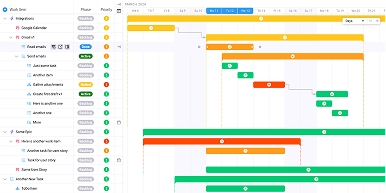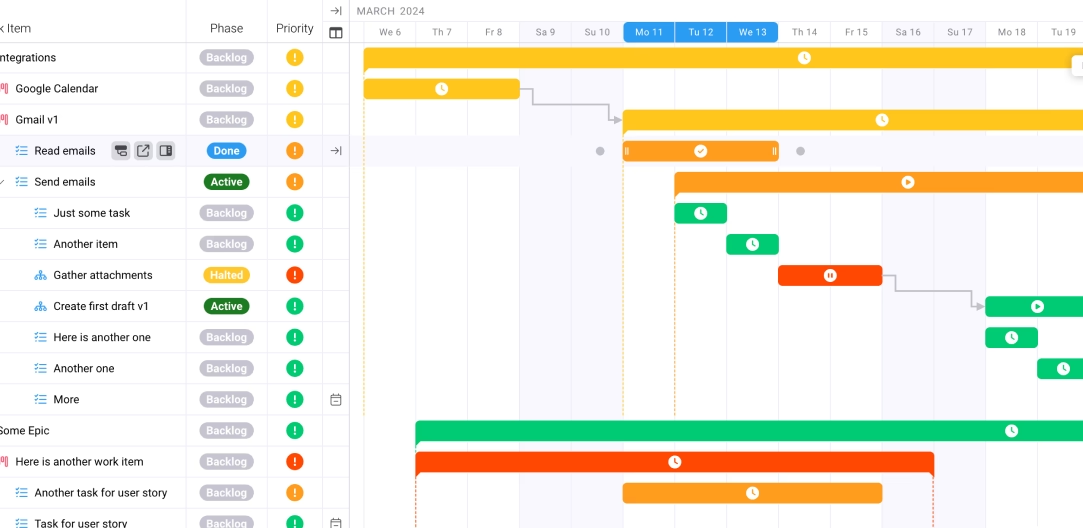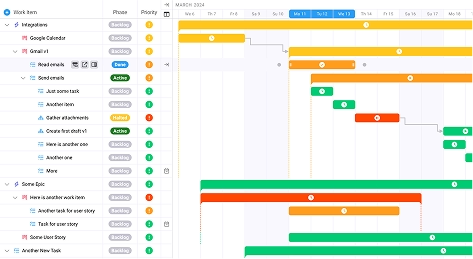
5 Reasons Generic Project Management Tools Fail Client Service Businesses
Key takeaways:
- Generic tools lack the specialized billing, time tracking, and client portal features that client service businesses require for profitability
- Integration failures cost organizations millions, with professional services firms particularly vulnerable to tool fragmentation
- Client communication breakdowns through generic platforms damage relationships and lead to project scope creep
- Resource planning inadequacies in generic tools result in over-servicing and profit losses across service industries
- Purpose-built solutions like Ravetree provide integrated workflows specifically designed for client service business success
Despite the promise of streamlined workflows and enhanced productivity, generic project management tools are systematically failing client service businesses across industries. While 84% of all integration projects failed according to recent studies, the root cause often lies not in implementation complexity, but in the fundamental mismatch between generic solutions and the nuanced demands of client service operations. For professional services firms, marketing agencies, and consulting companies, the stakes are particularly high—where client satisfaction directly drives revenue and generic project management tools can become expensive bottlenecks rather than productivity enablers.
Reason 1: Inadequate Financial Management and Billing Integration
The financial complexities of client service businesses extend far beyond basic project tracking, requiring sophisticated revenue recognition, time-based billing, and multi-currency support that generic project management tools simply cannot deliver effectively. Professional services firms operate on razor-thin margins where accurate billing and precise cost allocation can determine the difference between profit and loss on every client engagement.
39% of projects fail due to the lack of a project plan and clearly defined project goals, but for client service businesses, this failure rate multiplies when financial tracking becomes disconnected from project execution. Generic tools typically treat billing as an afterthought—offering basic time tracking without the nuanced financial controls needed for retainer management, milestone billing, or complex fee structures that characterize professional services work.
The challenge becomes even more pronounced when considering that 43% of B2B invoices are affected by late payments, creating cash flow pressures that demand immediate visibility into billable hours, pending invoices, and collection status. Generic project management platforms lack the integrated financial dashboards and automated billing workflows that keep service businesses financially healthy.
Most generic tools force teams to maintain separate systems for project tracking and financial management, creating dangerous data silos. When project managers update task completion in one system while finance teams track billing in another, the inevitable result is lost billable hours, incorrect invoicing, and frustrated clients receiving bills that don’t align with their understanding of project progress.
According to research from professional services industry leaders, 90% of PR agencies overservice accounts, with a significant portion of this overservicing attributed to poor visibility into real-time project profitability. Without integrated financial tracking, project managers cannot make informed decisions about scope management or resource allocation during project execution.
Reason 2: Lack of Specialized Client Communication and Portal Features
Client service businesses thrive on transparent, professional communication that builds trust and demonstrates value throughout project lifecycles. Generic project management tools treat client interaction as a secondary consideration, offering basic commenting systems and file sharing that fall short of the sophisticated client portal functionality required for professional services success.
The fundamental problem lies in how generic tools conceptualize stakeholder involvement. They’re designed for internal team collaboration, with client access added as an afterthought through limited guest permissions or shared project views. This approach creates several critical problems: clients receive notifications for every internal team discussion, project updates lack the professional presentation that builds confidence, and sensitive internal conversations about budget or timeline concerns become visible to clients.
Professional service providers need controlled client environments where they can curate the information clients see, present project progress in client-friendly formats, and maintain clear boundaries between internal operations and client-facing communications. Generic tools simply cannot provide this level of sophistication in client experience management.
The communication breakdown becomes particularly problematic during project delivery phases. When clients cannot easily access project status, review deliverables, or provide feedback through professional channels, they resort to email and phone calls—exactly the fragmented communication patterns that project management tools are supposed to eliminate. This creates a vicious cycle where the tool intended to improve client experience actually degrades it.
55% of businesses experience failed projects, and in many cases, these failures stem from communication breakdowns rather than technical issues. For client service businesses, maintaining professional communication standards isn’t just about efficiency—it’s about preserving the premium positioning that justifies higher service fees.
According to research outlined in top project management software for digital agencies, successful agencies require platforms that can seamlessly integrate client communication with project execution, ensuring that every client interaction reinforces professionalism and competence.
Reason 3: Resource Planning and Capacity Management Failures
Generic project management tools approach resource management through a task-assignment lens that fundamentally misunderstands how professional services firms operate. Unlike manufacturing or software development where resources are relatively fungible, client service businesses depend on matching specific skill sets, experience levels, and client relationship histories to project requirements—complexities that generic tools cannot effectively address.
The resource planning requirements for agencies and consultancies extend far beyond basic workload distribution. These businesses must balance billable utilization targets, skill development opportunities, client preferences for specific team members, and project profitability considerations when making resource allocation decisions. Generic tools typically offer simple capacity views and assignment capabilities that ignore these nuanced requirements.
Research demonstrates that SaaS applications used by organizations jumped over 1,300% in six years, from 8 in 2015 to 110 in 2021. This explosion of tools creates particular challenges for service businesses where resource planning must account for varying tool proficiencies across team members, training requirements for client-specific platforms, and the overhead costs associated with context switching between multiple systems.
The capacity management failures in generic tools become most apparent during peak business periods. When agencies need to quickly assess which team members have availability for urgent client requests, evaluate skill matches for new project opportunities, or redistribute workloads to meet tight deadlines, generic tools provide insufficient visibility and flexibility. The result is either over-promising to clients with impossible delivery timelines or under-utilizing expensive senior resources.
Generic tools also fail to account for the non-billable work that comprises significant portions of service business operations: business development, proposal writing, client relationship management, and internal training. Without proper visibility into these activities, resource planning becomes disconnected from business reality, leading to perpetual overcommitment and team burnout.
Industry analysis suggests that Simple projects have a far higher failure rate than complex ones when teams lack the necessary expertise, highlighting how generic tools can create false confidence in resource capabilities while obscuring critical skill gaps.
Reason 4: Integration and Workflow Automation Limitations
The technology ecosystem for professional services firms typically includes specialized tools for CRM, accounting, marketing automation, and industry-specific applications that cannot be easily replaced by generic project management features. Generic tools approach integration as a technical connectivity problem rather than a workflow optimization opportunity, resulting in fragmented systems that increase administrative overhead rather than reducing it.
The integration challenge becomes particularly acute for client service businesses because their workflows span the entire client lifecycle—from initial prospect qualification through project delivery to ongoing relationship management. Generic project management tools typically excel at task tracking and team collaboration but lack the sophisticated workflow automation needed to connect marketing qualified leads with project scoping, link project completion with invoicing processes, or integrate client feedback with service delivery improvements.
81% of ERP projects met ROI expectations according to Panorama Consulting Solutions, but this success rate drops significantly when organizations attempt to force generic tools into complex workflow requirements they weren’t designed to handle. Professional services firms require platforms that can orchestrate multiple business processes simultaneously while maintaining data consistency across all client touchpoints.
The automation limitations in generic tools create particular problems for scaling service businesses. As agencies grow, the manual overhead of transferring information between systems, updating multiple databases with the same client information, and maintaining synchronization across platforms becomes unsustainable. Generic tools lack the sophisticated automation capabilities needed to eliminate this administrative burden.
Modern client service businesses require seamless integration between time tracking, project delivery, and financial reporting. When these capabilities exist in separate systems with limited integration, teams spend excessive time on administrative tasks that could be automated with purpose-built platforms.
Research from leading industry analysts emphasizes that your client service business needs an all-in-one work management platform specifically because generic tools cannot provide the deep integration required for efficient service delivery.
Reason 5: Scalability and Customization Constraints
Generic project management tools are designed for broad market appeal, which necessitates standardized features and limited customization options that become constraining as client service businesses grow and develop specialized processes. The scalability limitations manifest in multiple ways: rigid permission structures that cannot accommodate complex client hierarchy requirements, limited custom field options that force businesses to compromise their data tracking needs, and inflexible reporting capabilities that cannot adapt to evolving client requirements.
Professional services firms often develop competitive advantages through specialized methodologies, unique service delivery approaches, or industry-specific processes that require platform flexibility. Generic tools typically offer basic customization through templates and workflows but lack the deep configurability needed to support truly differentiated service offerings.
The scalability challenge becomes most apparent when firms attempt to standardize processes across multiple service lines or geographical locations. Generic tools often force organizations to choose between maintaining their proven methodologies and adapting to platform limitations—a choice that can undermine service quality and competitive positioning.
As businesses scale, they also develop more sophisticated reporting requirements for different stakeholder groups: board-level profitability summaries, client-facing project status reports, operational efficiency dashboards, and regulatory compliance documentation. Generic tools typically offer standard reporting templates that cannot be easily modified to meet these diverse requirements without significant manual effort.
The customization constraints in generic platforms also limit their ability to evolve with changing business needs. When firms develop new service offerings, enter new markets, or adapt to regulatory changes, they need platforms that can quickly accommodate new workflows and data requirements. Generic tools often require extensive workarounds or expensive third-party integrations to support business evolution.
Industry research confirms that successful agencies require platforms with the flexibility to adapt to their unique requirements rather than forcing business processes to conform to software limitations. The guidance in how to choose the right work management platform for your agency emphasizes the critical importance of selecting solutions that can grow and adapt with business needs.
The Solution: Purpose-Built Platforms for Client Service Success
The systemic failures of generic project management tools in client service environments point to a fundamental truth: these businesses require purpose-built solutions that understand the unique challenges of professional services delivery. Unlike generic tools that attempt to serve all industries with standardized features, specialized platforms like Ravetree are designed specifically for the workflows, financial models, and client relationship requirements that define successful service businesses.
Purpose-built solutions address the integration challenges that plague generic tool implementations by providing unified platforms where project management, financial tracking, client communication, and resource planning work together seamlessly. This integration eliminates the data silos and manual processes that consume administrative resources and create opportunities for errors.
The sophisticated financial management capabilities in purpose-built platforms go far beyond basic time tracking to include automated billing workflows, retainer management, multi-currency support, and real-time profitability analysis. These features ensure that every project decision is informed by current financial performance and future revenue implications.
Client communication through purpose-built platforms maintains the professional standards that justify premium service fees while providing the transparency and accessibility that modern clients expect. Dedicated client portals, branded project reports, and controlled information sharing create superior client experiences that differentiate service providers in competitive markets.
Resource planning capabilities in specialized platforms account for the complexities of skill-based resource allocation, utilization optimization, and capacity forecasting that generic tools cannot address. This sophistication enables service businesses to maximize team productivity while maintaining service quality standards.
Measuring Success: KPIs and Metrics That Matter
Successful implementation of purpose-built project management solutions for client service businesses requires tracking specific metrics that reflect the unique success factors of professional services operations. Unlike generic project metrics focused on task completion and timeline adherence, service businesses must monitor financial performance, client satisfaction, and operational efficiency indicators that directly impact profitability.
Key performance indicators should include billable utilization rates across different skill levels, project profitability margins by client and service type, client retention and expansion rates, and average collection periods for outstanding invoices. These metrics provide immediate insights into business health and platform effectiveness.
Resource efficiency metrics become particularly important for scaling service businesses. Tracking the ratio of billable to non-billable hours, measuring the time between project completion and invoice generation, and monitoring client response times for project deliverables help identify optimization opportunities.
Client satisfaction metrics should extend beyond traditional project success measures to include platform usability scores, communication effectiveness ratings, and overall service delivery experience assessments. These indicators help ensure that operational efficiency improvements translate into enhanced client relationships.
Financial performance tracking through purpose-built platforms enables real-time profitability analysis that informs project decisions during execution rather than after completion. This capability transforms project management from reactive task coordination to proactive business optimization.
Future Considerations: Emerging Trends and Strategic Preparation
The professional services industry continues evolving rapidly, with emerging trends requiring platform capabilities that extend far beyond traditional project management functionality. Artificial intelligence integration for predictive resource planning, automated client communication workflows, and intelligent project scoping based on historical performance data represent the next generation of service business optimization.
The trend toward outcome-based pricing models rather than time-based billing requires platforms capable of tracking value delivery metrics alongside traditional project completion indicators. Purpose-built solutions are developing capabilities to measure client business impact, service delivery effectiveness, and long-term relationship value that generic tools cannot provide.
Remote and distributed team management continues requiring sophisticated collaboration capabilities that maintain client service standards across geographical boundaries. The platform requirements for managing global service delivery teams exceed the basic video conferencing and file sharing offered by generic tools.
Client expectations for real-time project visibility, self-service access to project information, and mobile-responsive communication platforms continue rising. Service businesses need platforms that can adapt to these evolving requirements without compromising security or professional presentation standards.
The increasing complexity of compliance requirements across different industries and geographical regions requires platforms with sophisticated permission management, audit trails, and reporting capabilities that generic tools typically cannot provide.
Strategic preparation for these trends requires selecting platforms with robust API capabilities, active development roadmaps aligned with professional services requirements, and vendor partnerships that ensure long-term platform evolution rather than feature stagnation.
Generic project management tools fundamentally fail client service businesses because they approach project management as a universal challenge rather than recognizing the specialized requirements of professional services delivery. The evidence is clear: from integration failure rates exceeding 80% to the systematic overservicing that plagues agencies using inappropriate tools, the cost of generic solutions far exceeds their apparent savings.
For operations directors, agency owners, and professional services leaders, the choice between generic tools and purpose-built platforms like Ravetree represents a strategic decision about operational efficiency, client experience quality, and long-term business scalability. While generic project management tools may appear cost-effective initially, their limitations in financial management, client communication, resource planning, integration capabilities, and customization options create ongoing operational inefficiencies that compound over time.
The solution lies in recognizing that client service businesses require specialized tools designed specifically for their unique workflows, financial models, and client relationship requirements. Purpose-built platforms provide the integrated functionality, sophisticated automation, and scalable architecture that enable service businesses to deliver exceptional client experiences while maintaining operational efficiency and profitability.
Frequently Asked Questions
What makes client service businesses different from other industries in terms of project management needs?
Client service businesses operate on relationship-based revenue models where client satisfaction directly impacts profitability, requiring sophisticated billing integration, professional client communication tools, and resource planning capabilities that account for skill-based allocation rather than simple task assignment.
How do generic project management tools impact client relationships?
Generic tools often expose clients to internal team discussions, lack professional presentation capabilities for client communication, and provide inadequate visibility into project progress, leading to increased email and phone communications that undermine the efficiency benefits the tools are supposed to provide.
What are the hidden costs of using generic project management tools in professional services?
Hidden costs include lost billable hours due to poor time tracking integration, over-servicing due to inadequate profitability visibility, increased administrative overhead from managing multiple disconnected systems, and client relationship damage from unprofessional communication experiences.
How can professional services firms evaluate whether their current tools are limiting growth?
Firms should assess integration complexity between systems, measure time spent on administrative tasks versus billable work, evaluate client feedback on communication and transparency, and analyze project profitability visibility during execution rather than only after completion.
What ROI improvements can firms expect from switching to purpose-built platforms?
Organizations typically see improvements in billable hour capture, reduced administrative overhead, faster invoice processing, improved client retention rates, and enhanced resource utilization, with many firms reporting 15-25% improvements in overall operational efficiency within the first year.









